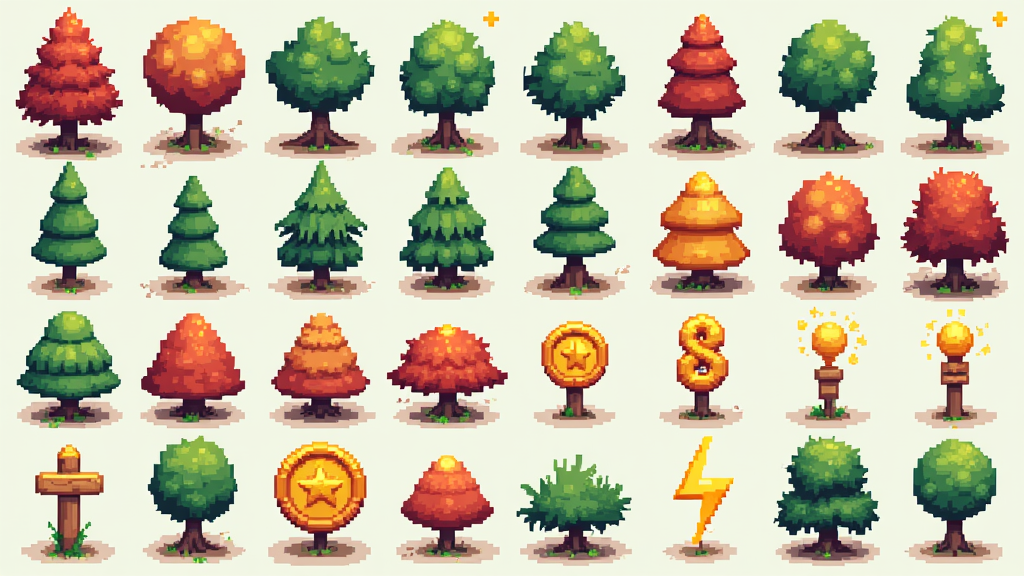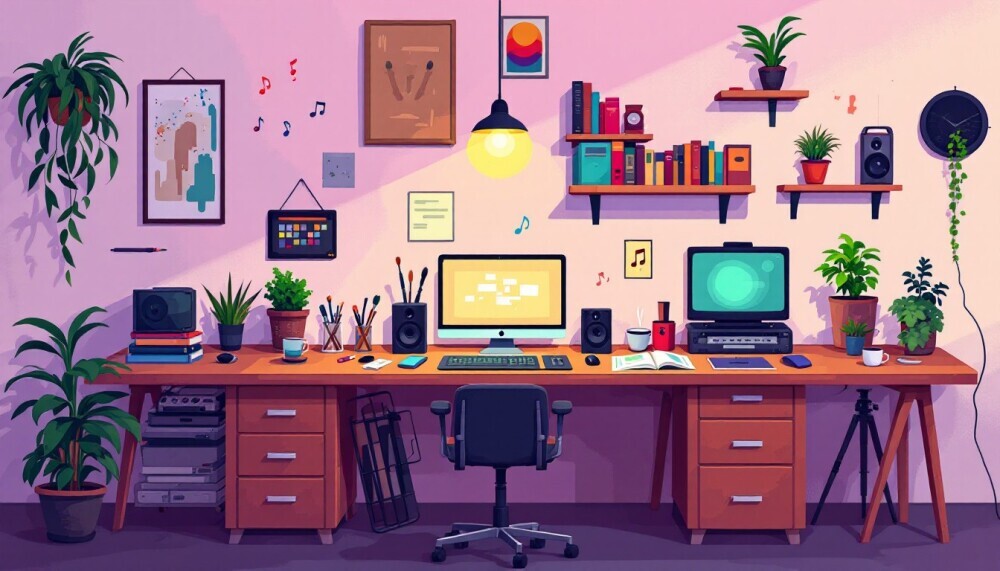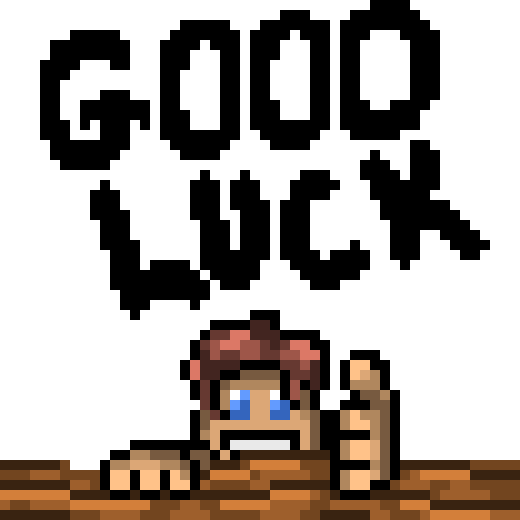Creating pixel game assets that share a unified style can make your game look professional, immersive, and memorable. Consistency is key when building a cohesive visual experience. It doesn’t mean all assets have to be identical, but they should share a natural and complementary feel in terms of color, scale, and detail.
Many game developers face challenges when producing pixel art for their games as they try to balance originality with a harmonious design. Some struggle with inconsistent outlines, clashing color palettes, or varying levels of detail between different asset types. With a strategic approach, however, it is possible to form a visually unified collection that strengthens your game’s overall design.
This guide is designed to help developers create and maintain consistency in pixel game assets. I’ll share steps and tips that you can adopt regardless of your skill level, so you can produce art that steps up gameplay, captures imagination, and builds character. By following these suggestions, you can streamline your art creation process and achieve a distinctive visual identity for your game.
Step 1: Define Your Visual Style
The foundation of a consistent art style is understanding exactly what you want your game to look like. Defining your visual style early on offers a clear direction for every piece of pixel art you create. Without clear guidelines, assets may quickly become mismatched and lose the unified feel you are aiming for.

Questions to Ask Yourself:
- What mood or tone do I want my game to reflect?
- Do I want a retro, nostalgic feel or a modern twist on classic pixel art?
- What level of detail is appropriate for the game’s resolution?
- What art influences or existing games inspire the look I’m aiming for?
- How will the style translate to animations and motion within the game?
Example Visual Styles:
- A minimalist pixel look with a limited color set and simple geometric shapes.
- A detailed, hand-crafted style that emphasizes shading and texture while still operating within the pixel art framework.
- A vibrant, cartoon-like style featuring exaggerated proportions and dynamic animations.
Once you have a clear vision of your style, document it thoroughly. Sketch examples, create mood boards, and decide on a set of rules that you can follow across all assets. When such guidelines exist, every new sprite or background element can be more effortlessly aligned with your game’s overall look.
Step 2: Choose a Consistent Color Palette

Your chosen color palette can either make or break the consistency of your pixel game assets. A well-chosen set of hues helps unify the visual appearance, even if asset shapes or details differ.
How to Choose a Color Palette:
- Start with a core set of colors. These might include primary colors for characters, environments, and interactive elements.
- Consider the mood and ambiance. Warm tones could evoke comfort and nostalgia, while cool tones might lend a mysterious or energetic feel.
- Limit your choices. Using too many colors can quickly lead to visual confusion. Many classic pixel games thrive on limited palettes.
- Test your palette with various asset types. Make sure that the selected colors work harmoniously when applied to sprites, backgrounds, and user interface elements.
Practical Tips:
- Use online palette generators for inspiration and to experiment with different combinations.
- Revisit and fine-tune your palette after you have produced a few assets. Often, initial ideas need altering once they are seen in context.
- Stick to your palette rules once the selection is refined. Consistency in color usage builds a stronger and more memorable style overall.
A focused color palette not only brings balance to your design but can also be used to signal transitions, highlight important elements, and keep your game’s overall look cohesive as more assets are added.
Step 3: Standardize Asset Dimensions and Resolution
Detail and scale are significant when it comes to making your pixel assets consistent. It is important to standardize the dimensions, pixel density, and resolution of your assets so that everything feels like it belongs in the same visual universe.
Methods to Standardize Dimensions:
- Decide on a base resolution for your game assets, whether it be as small as 16×16 pixels for characters or up to 64×64 pixels for more detailed designs.
- Create templates for common asset types. Templates ensure that every piece adheres to the same proportions and features when scaled or animated.
- Use a grid system. When working pixel by pixel, grids help maintain consistent margins, spacing, and a balanced level of detail.
Benefits of Standardization:
- Assets appear well-balanced on the screen, enhancing the overall user experience.
- Animation becomes simpler as key frames naturally align better due to consistent dimensions.
- Developers and collaborators can quickly recognize and modify assets, thanks to pre-established dimensions.
Standardizing asset dimensions reduces the need for constant adjustments later and prevents style mismatches. Employing a consistent approach allows you to minimize errors and produce a collection of assets that blend effortlessly with one another.
Step 4: Balance Detailing with Simplicity
Pixel art is an exercise in both simplicity and creative expression. Finding the right balance between minimalism and intricate detail can be challenging, yet it is essential for maintaining overall consistency in your art.
What to Consider:
- Keep details harmonized across assets. Overly detailed backgrounds paired with very simple character designs can create a visual clash.
- Simplify complex designs into recognizable shapes, ensuring that the details remain clear even when scaled down.
- Allow your style to guide the level of detail. Consistency means every asset, no matter its size, follows the same visual rules.
- Frequently take a step back and view your assets at their intended display size to gauge if the detailing aligns with the overall design.
Testing Your Details:
- Create comparison sheets featuring multiple assets to look for any details that appear out of place.
- Experiment by simplifying overly ornate designs while keeping essential visual cues intact.
- Invite feedback from peers or test players unfamiliar with the design process. Fresh perspectives can spot inconsistencies you might have overlooked.
A balanced approach results in game assets that are both accessible and visually appealing. Simplified detailing naturally creates a uniform look, while subtle nuances in style add charm without disrupting the overall presentation.
Step 5: Plan Your Asset Creation Workflow
Establishing a clear workflow makes the development of pixel assets much smoother and helps maintain consistency over time. A thoughtful process can reduce mistakes and streamline collaboration, particularly if you’re part of a team.
Elements of a Good Workflow:
- Sketch your ideas before moving on to pixel creation. Initial rough designs capture the vision without the pressure of perfection.
- Define asset categories such as characters, items, landscapes, and special effects. This segmentation ensures that every type of asset receives the necessary attention.
- Create a consistent naming convention. Organized file naming and structure help you locate and update assets quickly.
Step-by-Step Asset Process:
- Concept & Sketching: Begin with clear concepts that define the role and function of each asset. Quick sketches allow you to explore multiple ideas without overcomplication.
- Detailed Pixel Art: Once the concept is approved, move into pixel art tools to meticulously craft each asset. Use your predefined grid and color palette as guides.
- Animation and Testing: For assets requiring movement, develop test animations. Adjust individual frames so that the motion feels fluid and consistent with your established design rules.
Documenting each step and keeping a checklist is extremely useful. Not only does this help maintain quality and consistency, but it also saves valuable time during revisions.
Step 6: Optimize Your Design Setup
Your digital workspace has a direct impact on the final output of your art. Optimizing your design environment allows you to concentrate on the fine details that contribute to the overall consistency of your assets.

Ways to Streamline Your Design Environment:
- Stick to a consistent software toolset. Whether you choose Aseprite, Photoshop, or another program, using one platform minimizes variability in output.
- Arrange your workspace to reduce distractions. Group your palettes, grid settings, and frequently used tools together for immediate access.
- Set regular automatic backups of your work. Reliable backups prevent the potential loss of important progress and help maintain a revision history.
- Create templates for common tasks. Having pre-made grids and layer structures ensures consistency every time you begin a new asset.
An organized digital setup not only speeds up the creation process but also guarantees that each asset benefits from the same underlying technical standards. This uniform setup contributes directly to preserving a coherent style across all your work.
Step 7: Maintain Consistency Over Time
Even with solid planning and clearly defined guidelines, maintaining consistency in pixel game assets is an ongoing process. It takes continual reviewing and occasional adjustments to make sure your art style remains uniform as your game evolves.
Strategies for Ongoing Consistency:
- Review your assets periodically. Assess whether new work aligns with your original style and update your guidelines if necessary.
- Create a shared reference folder. If you’re working as a team, a central repository of style guides, palettes, and templates helps everyone stay aligned.
- Allow for minor adjustments without compromising the core style. Small tweaks might be needed to better suit new game mechanics or evolving aesthetics.
- Practice regularly. The more you work within the same framework, the easier it becomes to keep your art consistent over time.
Adopting consistent methods across projects builds muscle memory in your creative process. When issues arise, view them as opportunities to refine your system rather than as setbacks. Consistency is built gradually through persistent effort and a keen attention to detail.
Advanced Strategies for Pixel Art Consistency
Beyond the foundational steps, there are advanced strategies that can help you truly master the art of consistent pixel design. As you progress in your development, it helps to adopt a mindset where every element is seen as part of a larger puzzle. Taking time to review each piece and reworking any that feel out of place ensures that your game’s visual language remains clear and unified.
One highly effective strategy is setting up a routine review process. This involves periodically lay out your assets side by side to check if each one is matching the established style. Over time, you may spot subtle deviations a slightly off color in a sprite or an uneven outline in a background element. At this stage, instead of overhauling your entire design, focus on tweaking these aspects. This not only polishes the visual consistency but also boosts your confidence as you gradually refine your workflow.
Another key approach is to experiment with variations on the same theme. For example, if you decide that your character design should always include a specific set of visual cues, such as distinct shading or outlines, try creating several versions of the same asset using different techniques. After this round of experiments, evaluate which version best fits your overall visual narrative. This iterative process helps you pinpoint what truly works and reinforces your style guidelines for future work.
Collaboration also plays a vital role in advanced consistency strategies. When working with a team, set up regular design critique sessions where each member can share feedback. By discussing your work openly, you can collectively decide on adjustments that will benefit the entire project. Even if you’re working solo, seeking external reviews from fellow artists or community groups can provide fresh insights and inspire improvements.
In addition, integrating technology into your workflow can give your process an extra boost. Many design tools now offer features like adjustable grid overlays, automatic color matching, and even artificial intelligence suggestions for refining pixel art. Embracing these tools can help you maintain accuracy and consistency, especially when tackling complex scenes or intricate animations. Remember to keep experimenting—mix different techniques and remain open to what each creative session can teach you.
Finally, documenting these advanced techniques in your project logs is really important. Keeping a record of what worked well, what didn’t, and why certain decisions were made will serve as an all-in-one reference in the future. It not only speeds up the process of onboarding new team members but also reinforces the discipline of consistently applying a unified style throughout your game’s development.
Common Questions & Troubleshooting
What if my assets look inconsistent?
Examine your style guidelines, palette choices, and asset dimensions. Minor inconsistencies are common, especially when experimenting with new techniques. Revisit your original visual blueprint and adjust any assets that stray too far from your designated style.
How do I manage color variations without losing consistency?
- Stick to your predefined color palette. If variations seem necessary, integrate subtle tints rather than introducing entirely new colors.
- Regularly compare new assets with older ones to catch and correct any deviations early in the process.
- Apply adjustment layers or filters sparingly, using them to create a unified look across assets during post-processing.
What if I’m just starting out and feel overwhelmed?
Take it one step at a time. Begin with a small set of assets and gradually expand as you master the basic guidelines. Focusing on one aspect of the process at a time can make the overall task much less daunting.
Final Thoughts & Next Steps
Building a consistent collection of pixel game assets is a process that rewards careful planning and steady execution. Every decision from establishing your visual style to refining your workflow contributes to a cohesive final product that players can appreciate. Your assets become more than just images; they tell a story and deepen a player’s immersion in your game world.
Your Action Plan:
- Document your visual style and set clear guidelines for colors, dimensions, and detailing.
- Establish a unified color palette and design template to adhere to for every asset you produce.
- Create and follow a structured workflow that includes concept sketches, detailed design, and meticulous testing.
- Regularly review your work to ensure that every new asset aligns perfectly with your established standards.
This thorough approach not only helps you sharpen your pixel art skills but also sets a very important standard for any project. Whether your game is an indie experiment or a commercial venture, having a consistent visual identity can boost the game’s appeal and recognition. What part of your pixel game asset process are you planning to refine first? Take some time to reflect on this and share your ideas with your team or in your project notes.
